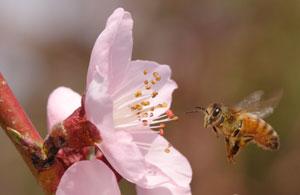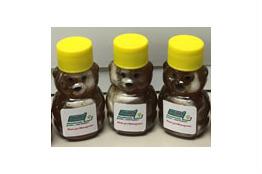Bees and beekeepers play an important role in the Commonwealth's agriculture. Beekeepers raise bees, which pollinate crops and provide us with honey and other products.
Beekeeping in Massachusetts
Massachusetts is home to a diverse and active beekeeping industry, with current estimates indicating 6,000–6,500 beekeepers managing 40,000–45,000 honey bee colonies across the Commonwealth. More than 45% of Massachusetts agricultural commodities rely on bees for successful crop pollination. Beyond their essential pollination services, honey bees also contribute valuable hive products such as wax, propolis, royal jelly, and honey. Collectively, beekeepers in Massachusetts produce an estimated 1.5 million pounds of honey each year.
Are you a beekeeper selling honey and would like to be listed on the MassGrown Map? If so, please fill out survey form.
You can also request MassGrown honey stickers and posters here to use as marketing materials.
About honey bees
Honey bees collect nectar from flowers and transform it into honey using specialized enzymes and evaporative processes within the hive. They store the finished honey in wax-sealed cells for future use. Although a single worker bee produces only about 1/12th of a teaspoon of honey in its lifetime, the colony’s collective effort is remarkable—it takes roughly 2 million flowers and bees flying 50,000 miles to produce just one pound of honey. Working together, a healthy hive can make several hundred pounds of honey in a year. Bees use a portion of this honey as food and store the rest to sustain the colony through winter. Because honey bees often produce more honey than they need, beekeepers responsibly harvest the surplus for human consumption.
Types of honey
Honey is sold in several forms, with the most common being comb honey, liquid honey, and creamed honey. Comb honey consists of natural sections of honey-filled wax comb taken directly from the hive. Liquid honey—the most familiar form—is produced by extracting honey from the comb and straining it until smooth.
Over time, most liquid honey will naturally crystallize, transforming from a liquid to a semi-solid state. Many people mistakenly believe crystallized honey is spoiled or unsafe to eat. This is false—properly sealed natural honey never expires. Crystallization only changes the honey’s color and texture, not its flavor or safety. If your honey crystallizes, simply place the container in a warm water bath (about 130–140°F, often achievable with hot tap water). Avoid microwaving or boiling, especially in plastic containers, as this can melt the plastic and compromise the honey. Once the crystals dissolve, give the honey a stir and it will return to its smooth liquid form.
Crystallization is influenced by temperature—honey stored between 50–59°F is more likely to crystallize—and by the ratio of glucose to fructose, with higher-glucose honeys crystallizing more quickly. Creamed honey is intentionally produced by blending crystallized honey into liquid honey to achieve a smooth, spreadable texture. This specialty product may be less widely available than liquid or comb honey.
Local beekeepers harvest fresh honey from late spring through mid-fall, so availability can be seasonal. It’s always a good idea to call ahead when seeking local honey products.


